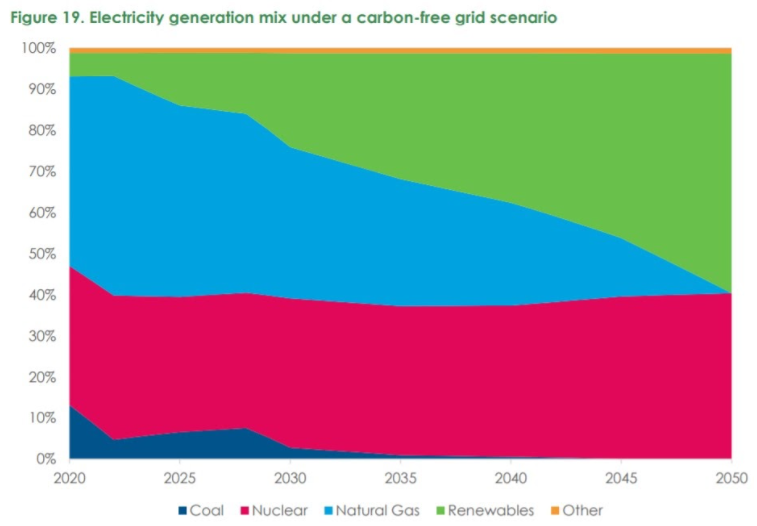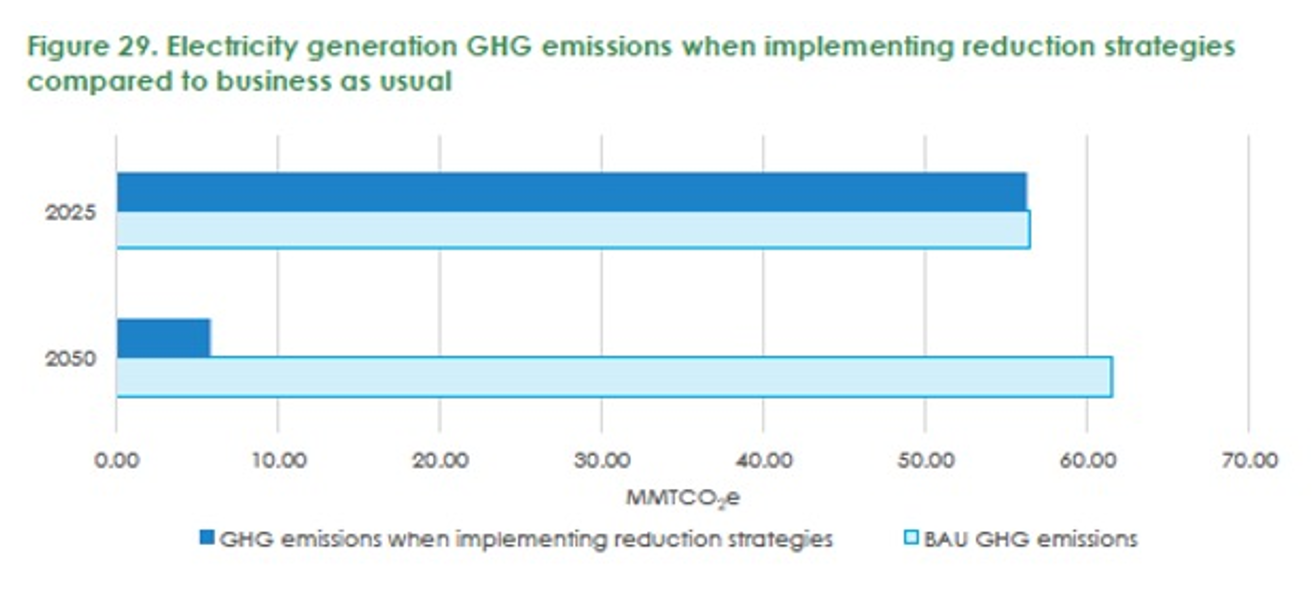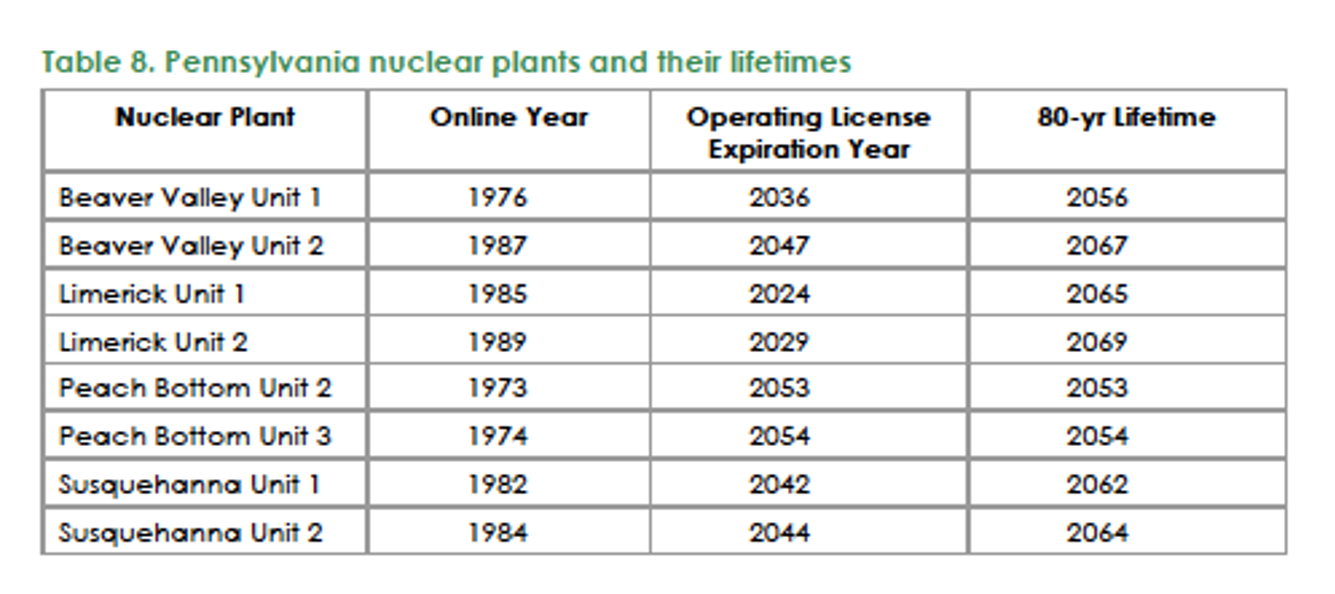By Sierra Club Pennsylvania's Dirty Energy Team
On the road to carbon-free electric power, the Action Plan assumes nuclear generation will continue to supply about 30% of the Commonwealth’s electricity through 2050. Although nuclear does not emit greenhouse gases, it is fundamentally dirty, generating radioactive waste with half-lives of up to 100,000 years.
Keeping all nuclear plants on-line through 2050 presumes Pennsylvania would subsidize them to prevent any retirements before then. Both prolonging nuclear operations, and diverting funds to do it are undesirable.
Pennsylvania law requires the Department of Environmental Protection to update its Climate Impacts Assessment and Climate Action Plan (CAP) every three years. The most recent releases were May 2021 and September 2021, respectively. The Climate Impacts Assessment estimates the Commonwealth’s current level and sources of greenhouse gas (GHG). The CAP then projects the Commonwealth’s GHG emissions in 2025 and 2050, given, first, business-as-usual (i.e., no new initiatives on GHG) and, second, the adoption of a suite of strategies to reduce GHG emissions. The Governor, by Executive Order in 2019, set goals to reduce GHG emissions by 26% from 2005 levels in 2025 and by 80% in 2050.
Earlier postings to the website for the Sierra Club’s Pennsylvania Chapter provide additional background on the CAP generally (posted 12.9.2021) and its treatment of the transportation and clean energy sectors (12.9.2021 and 1.28.2022).
The CAP identifies eighteen strategies for reducing GHG emissions in seven economic sectors: Residential and Commercial Buildings; Transportation; Industrial; Fuel Supply; Electricity Generation; Agriculture; and Waste. At 30%, Electricity Generation accounted for the greatest share of GHG among the seven. Conversely, the CAP describes how Electricity Generation could see the greatest reduction in GHG among the seven. Emission reductions in the six other sectors depend in part on developments in Electricity Generation. For instance, burning less coal and gas to heat buildings requires greater reliance on clean electrical power.
This note looks at the role of nuclear power under the CAP in reducing GHG from electric generation. Falling costs for renewable energy, along with the Commonwealth’s policies promoting its adoption, have increased the share of renewable energy in Pennsylvania’s power mix.
Emissions from Electricity Generation have diminished by 38% from 2005 to 2017([1]) and by 7% from 2016 to 2017 alone. This was due primarily to (i) reduced generation from coal (offset by increases in natural gas), (ii) energy efficiency improvements (encouraged under the Alternative Energy Portfolio standards), and (iii) increased generation from alternative and renewable energy sources.
Coal-based generation (including waste coal) decreased from 56% of Pennsylvania’s total electricity in 2005 to 22% in 2017. At 39%, nuclear power was the largest source of electricity generation in 2017, followed by natural gas (34%), coal (22%), renewables (4%), and other (1%). By 2020, natural gas had moved ahead of nuclear and is forecast to provide an increasing share of electricity. Nonetheless, Pennsylvania is the nation’s second largest producer of nuclear power.
The CAP contemplates two strategies for reducing GHG from Electricity Generation:
- Maintain nuclear generation at current levels; and
- Create a carbon-emissions-free grid.
The CAP calls the first a near-term initiative because the nuclear plants are online now. Maintaining nuclear generation would, however, require all plants to stay on-line through 2050. Between now and then, renewable power is seen as developing the efficiency and scale to entirely supplant fossil fuel in generating electricity. Thus, in 2050, the energy grid would be carbon-free - all electricity would derive from a combination of renewable and nuclear power.

Nuclear produces a steady power output in all weather and seasons. Output from renewables vary with, for instance, sunshine and wind. Consequently, the emergence of renewables as a gradual replacement for renewables makes power storage increasingly important to compensate for renewables’ variability. The CAP anticipates four-hour battery storage for nearly 47 gigawatts of power will be necessary to balance the intermittency of sunshine and wind.
The CAP provides one scenario for 2050. Others will likely emerge as technologies develop. For instance, the CAP notes possible roles for CCUS (carbon capture, use, and sequestration), hydrogen power, and distributed energy suppliers. Such developments could change how Pennsylvania ultimately achieves its goal for 2050.
The net result of eliminating coal and gas would be:

Achieving zero-GHG electric generation would thus depend substantially on nuclear power, which poses health and environmental risks. Nuclear plants emit no GHG and are considered by some to be clean, if only in that respect. They are, however, fundamentally dirty, generating radioactive waste with half-lives of up to 100,000 years
For nuclear plants to stay on line at least through 2050, the CAP assumes an 80-year lifespan for all those now in service. Operators of nuclear plants can apply to the Nuclear Regulatory Commission for two 20-year extensions of their operating licenses, stretching functional lifetimes to 80 years. Two of Pennsylvania’s eight plants already have such 80-year licenses. Six others would require one or two extensions to reach 80 years. The following table lists the plants, the current expiration years of their licenses, and their retirement years after 80-year lifetimes.

Keeping all nuclear plants on-line through 2050 presumes Pennsylvania would intervene to prevent any retirement before then. Consequently, utilities may look to the Commonwealth to subsidize their nuclear plants to preserve their economic viability in the face of increasing operating costs and declining revenues - as cheaper renewable energy increases its advantage over more expensive nuclear energy.
The CAP accounts for the costs and benefits of this tactic under the broader strategy for a Carbon Emissions Free Grid. Environmental and social benefits of this strategy include reducing emissions from fossil electricity sources, including (i) GHG such as CO2, CH4, and N2O (Carbon Dioxide, Methane, and Nitrous Oxide), (ii) particulate and other gaseous emissions, such as NOX, SOX, PM2.5, and (iii) VOCs (Nitric Oxide, Sulfur Dioxide, Fine Particulate Matter, and Volatile Organic Compounds). This would directly constrain carbon emissions that blight public health.
Continuing advances in technology and scale suggests that renewables will ultimately displace nuclear. Implicit in the CAP is, however, that replacing nuclear capacity with renewable capacity only after 2050 would be more cost-effective and practicable than if nuclear capacity were to retire before then. That strategy does not account for the hazards posed by continuing operation of nuclear plants.
Developing the technology for renewables to replace nuclear power by 2050 presents a 28-year horizon. Achieving that goal may well require as-yet undeveloped technologies. Consequently, the CAP recognizes that advancing renewables through 2050 will require governmental support of solar and wind projects across Pennsylvania, as well as legislation to promote the development of renewables. In the current political and economic climate, this is an aggressive ask.
The Sierra Club’s View
Considered by itself, nuclear generation is undesirable and dangerous. Although nuclear power may be “clean” with respect to direct GHG and other air pollution emissions, it is, dirty over the longer term. It produces radioactive waste and an array of associated risks.
Disposing of this waste entails current risks, such as for storage, transportation and entombing. Longer term disposal entails risks that countries with nuclear generation are only beginning to comprehend. Long term disposal poses risks of radioactive substances migrating offsite and into the air and ground and surface waters. There is currently a lack of approved waste disposal sites, and the technology does not exist to guarantee containment of radioactive waste for as long as it remains dangerous. With a half- life of thousands of years, it is irresponsible to keep generating waste that we cannot dispose of safely. Even disposal techniques that promise, say, a one-hundred-year safe horizon are as yet unproven.
One hundred years is within the lifespan of our children, grandchildren, and great-children, born and unborn. They will be facing the hazards. The corporations and people who profited from the plants, however, may no longer exist, and the cost of addressing the hazards of radioactive waste may be borne by these future generations. With clean and safe alternatives available, nuclear risks from human error, technological failure, and natural events are unacceptable in a nuclear industry that is obsolescing and increasingly unnecessary.
The Sierra Club’s position on nuclear is clear and direct:
The Sierra Club remains unequivocally opposed to nuclear energy. Although nuclear plants have been in operation for less than 60 years, we now have seen three serious disasters. Tragically, it took a horrific disaster in Japan to remind the world that none of the fundamental problems with nuclear power have ever been addressed.
Besides reactor safety, both nuclear proliferation and the required long-term storage of nuclear waste (which remains lethal for more than 100,000 years) make nuclear power a uniquely dangerous energy technology for humanity. Nuclear is no solution to Climate Change and every dollar spent on nuclear is one less dollar spent on truly safe, affordable and renewable energy sources.
The risks and rewards of nuclear versus renewables highlight the imperative of replacing nuclear. Thus,
- We envision an energy efficient world, powered by clean, renewable technologies, free from dirty, dangerous, costly nuclear power and its legacy of toxic waste.
- We aim to stop proposed new nuclear plants and license extensions of old plants.
- We support efficiency, solar, wind, and geothermal as sustainable sources of electricity.
- We are working to address the mounting problems of radioactive waste.
- We are concerned about the effect of the entire nuclear fuel cycle on people and the planet.
- Nuclear energy is risky, dirty, dangerous, slow, and expensive. Unnecessary too!
- Solar, wind and geothermal power and efficiency — all faster, cheaper, cleaner, and safer!
(Sierra Club Grassroots Network Nuclear Free Campaign, Downloaded April 19, 2022)
Nuclear energy is not safe, affordable, or clean. Renewable energy is far cheaper and progressively more ready to scale up to replace nuclear without need for natural gas.
The best course is to phase out nuclear as quickly as feasible and replace it with a robust renewable capacity and infrastructure.
The Sierra Club’s website has more on its policy regarding nuclear power here.
The Sierra Club will make rare exceptions to its opposition to nuclear. It may support a public policy proposal that includes nuclear power if, overall, the proposal (i) strongly favors efficiency, renewable energy, and greenhouse gas reductions and (ii) has only insubstantial environmental impacts.
Any subsidy for aging nuclear plants must be for a specified period only, affordable for Pennsylvanians, and paired with policies that ensure the plants’ replacement with efficiency and renewables, all the while helping workers and host communities to navigate the transition. Subsidies should also require plant operators’ to accept environmental, safety, and decommissioning criteria that exceed federal standards.
Propositions to continue nuclear power deserve consideration, not reflexive dismissal. We want to avoid widespread nuclear plant retirements that may materially increase reliance on coal and gas - as seen with Germany’s nuclear phase-out. Renewable energy will require time scale up. Accordingly, we have always prioritized replacing fossil fuels with renewables and efficient technology before attempting to replace existing nuclear plants with cleaner forms of energy.
([1]) 2017 is the most recent year for which the EPA has released the data that the Department of Environmental Protection uses to determine the Commonwealth’s GHG inventory.
This blog was included as part of the August 2022 Sylvanian newsletter. Please click here to check out more articles from this edition!